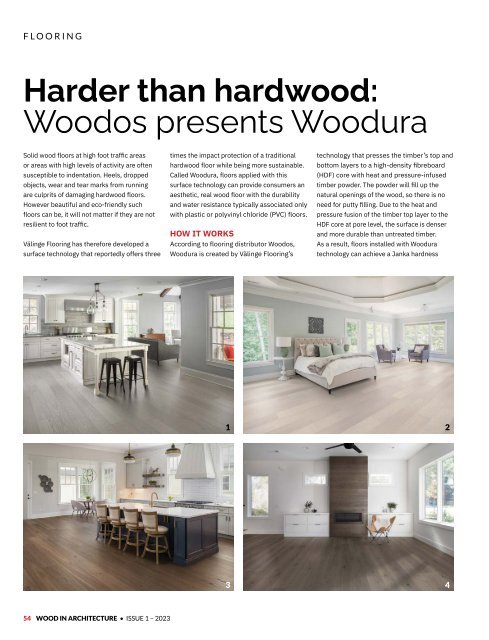Wood In Architecture Issue 1, 2023
First published in 2017, Wood in Architecture (WIA) is a bi-annual trade magazine devoted to the international timber construction sector. The newest addition to the Panels & Furniture Group of wood magazines, WIA features in-depth insights to the latest industry news, incredible projects and leading trade events. WIA is an advocate for timber as a material of choice for today’s built environment, and is the perfect source of inspiration for architects, builders, engineers and interior designers across the globe.
First published in 2017, Wood in Architecture (WIA) is a bi-annual trade magazine devoted to the international timber construction sector. The newest addition to the Panels & Furniture Group of wood magazines, WIA features in-depth insights to the latest industry news, incredible projects and leading trade events. WIA is an advocate for timber as a material of choice for today’s built environment, and is the perfect source of inspiration for architects, builders, engineers and interior designers across the globe.
- No tags were found...
Create successful ePaper yourself
Turn your PDF publications into a flip-book with our unique Google optimized e-Paper software.
FLOORING<br />
Harder than hardwood:<br />
<strong>Wood</strong>os presents <strong>Wood</strong>ura<br />
Solid wood floors at high foot traffic areas<br />
or areas with high levels of activity are often<br />
susceptible to indentation. Heels, dropped<br />
objects, wear and tear marks from running<br />
are culprits of damaging hardwood floors.<br />
However beautiful and eco-friendly such<br />
floors can be, it will not matter if they are not<br />
resilient to foot traffic.<br />
Välinge Flooring has therefore developed a<br />
surface technology that reportedly offers three<br />
times the impact protection of a traditional<br />
hardwood floor while being more sustainable.<br />
Called <strong>Wood</strong>ura, floors applied with this<br />
surface technology can provide consumers an<br />
aesthetic, real wood floor with the durability<br />
and water resistance typically associated only<br />
with plastic or polyvinyl chloride (PVC) floors.<br />
HOW IT WORKS<br />
According to flooring distributor <strong>Wood</strong>os,<br />
<strong>Wood</strong>ura is created by Välinge Flooring’s<br />
technology that presses the timber’s top and<br />
bottom layers to a high-density fibreboard<br />
(HDF) core with heat and pressure-infused<br />
timber powder. The powder will fill up the<br />
natural openings of the wood, so there is no<br />
need for putty filling. Due to the heat and<br />
pressure fusion of the timber top layer to the<br />
HDF core at pore level, the surface is denser<br />
and more durable than untreated timber.<br />
As a result, floors installed with <strong>Wood</strong>ura<br />
technology can achieve a Janka hardness<br />
1<br />
2<br />
3<br />
4<br />
54 WOOD IN ARCHITECTURE • ISSUE 1 – <strong>2023</strong>


















